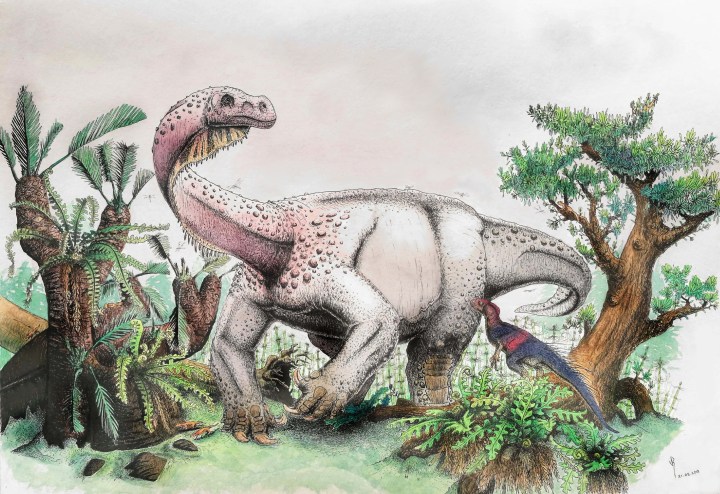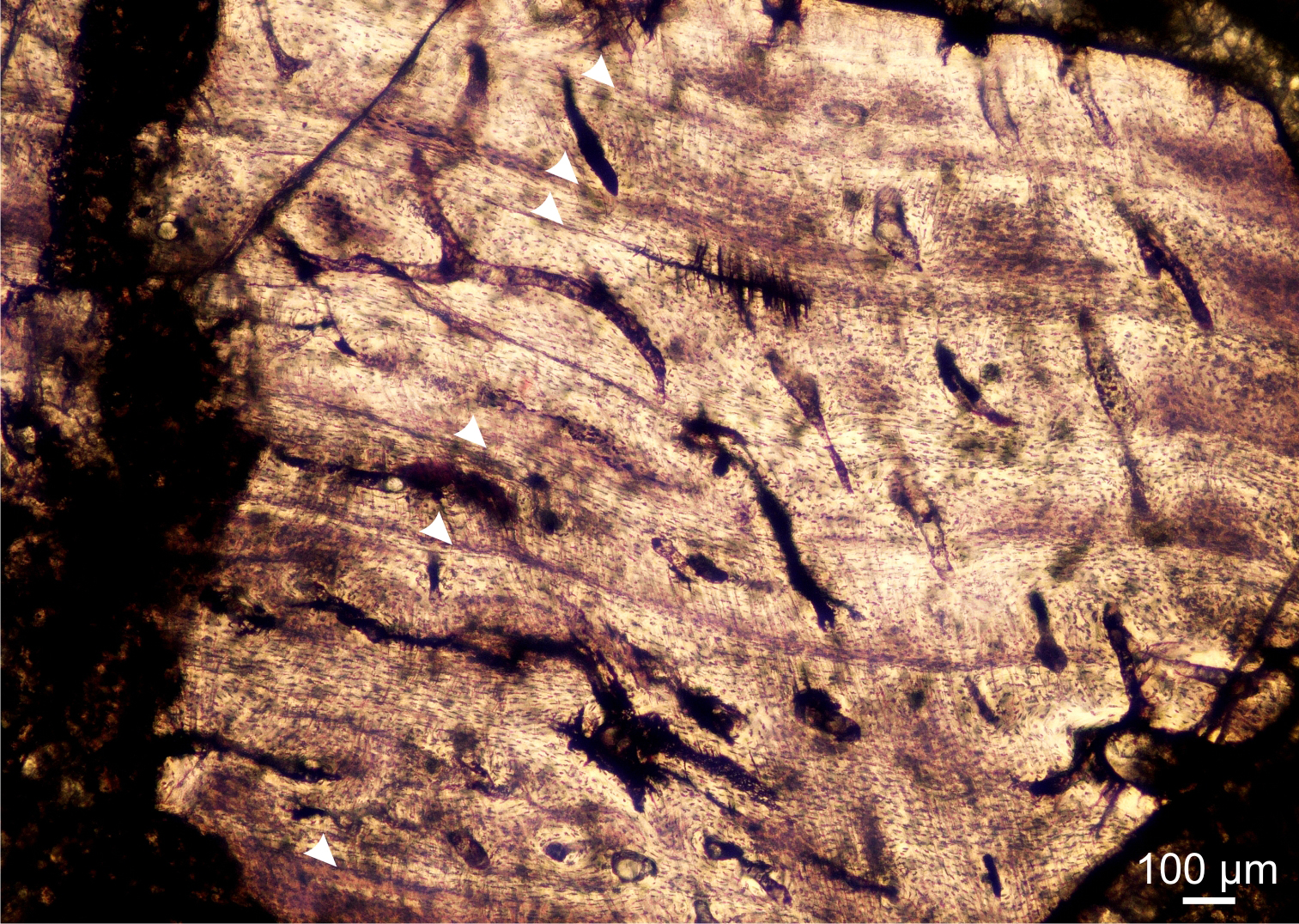Jurassic Park
Hunt finally reveals a ‘giant thunderclap at dawn’

A treasure hunt that lasted a decade has finally yielded a new species of giant dinosaur that roamed the borderlands of the Free State 200-million years ago.
Ledumahadi mafube, a plant-eating dinosaur was big, so much so that it was probably the largest land animal of its time.
This beast probably weighed double the size of a large bull elephant, clocking in at around 12-tonnes and standing four metres tall at the hip.
Today an international team of scientists announced the discovery of this plant-eating dinosaur that they named Ledumahadi mafube, which is Sesotho for “a giant thunderclap at dawn”.
Why palaeontologists are excited about Ledumahadi is that they argue it marks a point in evolution where dinosaurs began super-sizing.
From the 12-tonne Ledumahadi, dinosaurs over the next millions of years would continue to experiment with size, until sauropods would weigh up to 60-tonnes.
“The name reflects the great size of the animal as well as the fact that its lineage appeared at the origins of sauropod dinosaurs,” says Professor Jonah Choiniere of Wits University, who led the team.
The description of the new species appears in the latest journal of Current Biology.
But what was unusual about this find is that Ledumahadi’s discovery wasn’t made out in the field; this dinosaur was found on a shelf in the collection room of the Evolutionary Studies Institute at Wits university.
For nearly 20 years a vertebra fossil stood alongside other bones on a shelf largely unnoticed, until palaeontologist Dr Adam Yates decided to take a closer look.
Yates believes he first saw it when he arrived at what was then the Bernard Price Institute for Palaeontological Research in 2001.
By 2008 he was taking a keen interest in the fossil and wrote about it in his blog.
“It isn’t brilliantly preserved, nor has it been properly prepared yet but it is worthy of note because it is BIG,” he wrote in his blog.
“This means that the Triassic of South Africa was harbouring a sauropodomorph whose tail base, at least, was similar in size to that of one of the larger Morrison neosauropods. I find that …. unexpected, to say the least.”
He added: “The answer is hopefully out there in the relatively unexplored exposures of the Elliot Formation.”
Yates decided he was going to find it.
The fossil catalogue revealed that the fossil was discovered by famed palaeontologist Dr James Kitching in 1990, near Clarens, in the Free State.
Kitching was legendary when it came to spotting fossils.
“He was an extraordinary man, he had a skill at reading the fingerprints in the rock better than anyone else. From the air or even a moving train he could spot where fossils could be,” explains Yates, who is now based that the Museum of Central Australia in Alice Springs. “They claimed he had x-ray eyes.”
Kitching died in 2003, but Yates stumbled on two clues. One was the name of a farm and the other a newspaper clipping that contained a black and white photograph of where Kitching found the fossil.
After asking around the Free State town of Clarens, Yates was able to find the spot.
The site lay on the side of a steep mountain, close to the Caledon River and the Lesotho border.

Closely spaced growth rings at the periphery of the fossil show that the animal is an adult. (Wits University)
“Because it was steep, it was awkward to excavate,” recalls Yates.
The new find got the nickname the Highland Giant and for the next couple of years the name stuck.
Yates later emigrated to Australia, and Dr Blair McPhee, the lead author on the paper, took over the excavation.
Over the years he was able to find more bones.
“The first thing that struck me about this animal is the incredible robustness of the limb bones,” says McPhee.
One important characteristic, the team was able to work out about Ledumahadi was how the dinosaur walked.
There was speculation that it might have walked on two legs, with the support of its tail, similar to other dinosaurs of this period.
The team used a new method, where they measured Ledumahadi’s limbs and compared them to modern animals, including mammals.
Choiniere explains: “We found that we could predict to 90-95% of the time if a mammal was a biped or quadruped just from the limb measurements alone without ever viewing that animal. So we could now apply that to extinct animals.”
They concluded that Ledumahadi walked on all fours.
The scientists also established Ledumahadi’s age at time of death.
Dr Jennifer Botha-Brink from the South African National Museum in Bloemfontein used osteohistological analysis to analyse the fossil’s bone tissue.
“We can tell by looking at the fossilised bone micro-structure that the animal grew rapidly to adulthood. Closely-spaced, annually deposited growth rings at the periphery show that the growth rate had decreased substantially by the time it died,” says Botha-Brink, who concluded that Ledumahadi did reach adulthood.
Ledumahadi’s world would have been dry, believe the palaeontologists. A modern comparison of the landscape, says Choiniere, would be the bushveld in the far north of Limpopo or the Kruger National Park.
But there would have been enough food available to sustain a beast the size of Ledumahadi.

Ledumahadi mafube is the first of the giant sauropodomorphs of the Jurassic. (Wits University)
In this world Ledumahadi would have been king, but it is also a landscape it probably shared with large shadowy predator.
In the same collection room where Ledumahadi was found lies a scimitar shape fang that is about 10cm long.
Yates found it and called it Carnivore X. The rest of Carnivore X hasn’t been found as yet, but it was big. Perhaps seven metres long, Yates has suggested in the past.
“I would dearly dearly love to know more about that animal, but unfortunately it was the one that got away. But it must be there somewhere,” says Yates.
“I think an adult Ledumahadi would have been immune to predation, but then again, crazy things can happen in nature.” DM

















 Become an Insider
Become an Insider